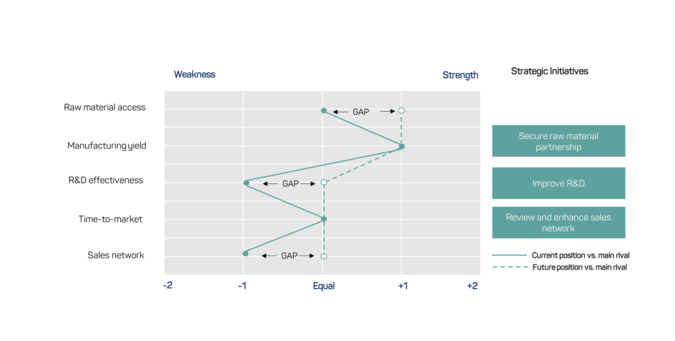
A far more effective SWOT – and its use in strategy formation
A common approach to strategy formation is to establish the current state, then the desired future state, and then assessing the gap between the two. Some organizations have found it useful to start by identifying their industry’s critical success factors (CSF) by generating a list of the top three to six things in which the organization needs to excel in order to compete in its particular business. By ranking its performance on these factors they evaluate strengths and weaknesses compared to their main competitors. This can easily be visualized as illustrated in the fictive example of a manufacturing firm illustrated below. Entering future performance reveals key gaps that needs to be addressed by strategic initiatives. Firms can choose if they want to use the desired or anticipated future depending on the needs of their decison process.

If the CSFs are listed in order of importance, they provide a starting point for identifying opportunities and threats. Opportunites are strengths that are expected to move up in importance, while threats are weaknesses moving up in importance. The firm now possesses a non-exhaustive list of factors that needs to be reviewed and supplemented. But it is very useful as the S.W.O.T. resulting from this procedure tends to be much clearer in its categorizations and far more relevant than the typical laundry-list-of-factors that we often see after brainstorming S.W.O.T. exercises.
It is also possible to use GAP analysis as a component in corporate foresight – after discussing futures, visions, and paths – to find out what needs to be done and what resources are required to achieve the strategy. Discussing the future is before the present in this manner reduces the risk for the latter shaping mental frames in ways that inhibits visionary thinking.
References:
- Bengtsson & Skärvard, 1988, Företagstrategiska perspektiv
- Fahey and Randall, 1998, Learning from the future: Competitive foresight scenarios
- Meissner and Wulf, 2015, Development of strategy scenarios based on prospective hindsight
- SNS, 1964, Företagets långsiktsplanering: motiv, innebörd, utformning, organisation, samband med offentlig planering
See original blogpost here.
